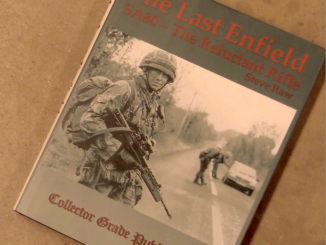While many people are familiar with the Ishapore 2A1 rifles chambered in 7.62mm NATO (largely thanks to their importation and sale in the US in large numbers), production of Indian Enfield rifles actually dates back to 1905, when the Ishapore arsenal was opened. The first rifles produced there were a batch of 3,000 MkI Enfield rifles in 1908/9. These were of course early pattern SMLEs, with features like split charger bridges, volley sights, and magazine cutoffs. Production quickly changed to the No1 Mk III pattern of rifle, which had been formally adopted in Britain in 1907.
During World War One, the need for arms led to those first early rifles being rebuilt in the MkIII configuration, but they retain their original markings, showing their origin. Today we have one of those first 3,000 to look at.



I’m very certain that the British were never interested in giving the Indian Army the newest toys in the store…
It’s interesting to note that while the British (and Canadian, Australian, New Zealand, etc.) armies adopted the Bren gun, the British Indian army adopted the superficially similar but different Vickers-Berthier. The VB LMG was also made at Ishapore.
Perhaps the reason why the VB was favored in India was the design being much simpler (and therefore faster and more efficient) to produce than that of the Bren! The VB was two pounds avoirdupois heavier and slightly bulkier, so production simplicity seems to be its only forgiving feature. But then again, the design was modified into the aircraft-mounted (and later SAS jeep-mounted) Vickers K, with high capacity ammunition pans and a ludicrously high cyclic rate which reduced many an unsuspecting Axis soldier to hamburger!
Did I mess up?
“VB”
http://www.acant.org.au/Articles/VickersMGs.html states that in trials for new machine gun VB occupied first place, followed by ZB26, Madsen and BAR, however endurance test favored ZB26 anyway British-Indian army, tired of the prolonged testing and in 1933 adopted the Vickers-Berthier as the force’s LMG
The ROF of the Vickers K G.O. was fairly standard for a 1930’s aircraft machine gun. For ground use it was pretty high and only second to the MG42. The SAS and LRDG liked it, because it was better suited for hit-and-run tactics with than the relatively slow firing British standard MGs. It also made a lot more convincing AA weapon, which was always a plus in the open desert.
Dang. All I get is the Nikon commercial. Video won’t load….
And yet Edward was King Emperor until his death in 1910, so if it was made in 1909 it would have been marked ERI under the crown.
It looks like maybe the G was substituted later, since it’s out of register? Is there a trace of the original E, or of its removal?
I find your knowledge and input very informative. Keep up the good work
Did enfield make India Pattern rifles? I have a 410 ishapore conversion and it is marked shtle 1** IP, it is also marked enfield with the kings crown. Made in 190?. maybe it was restamped when it came into India but it has the magazine cutoff cutout, the updated charger bridge, and is marked HV behind the rear sight.